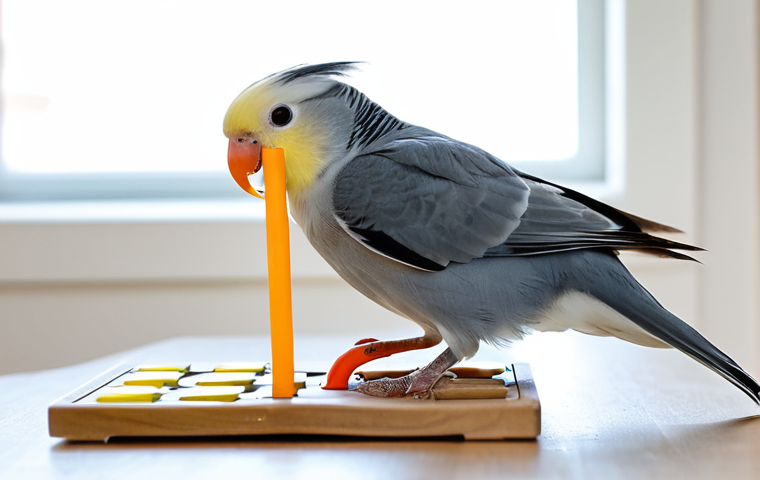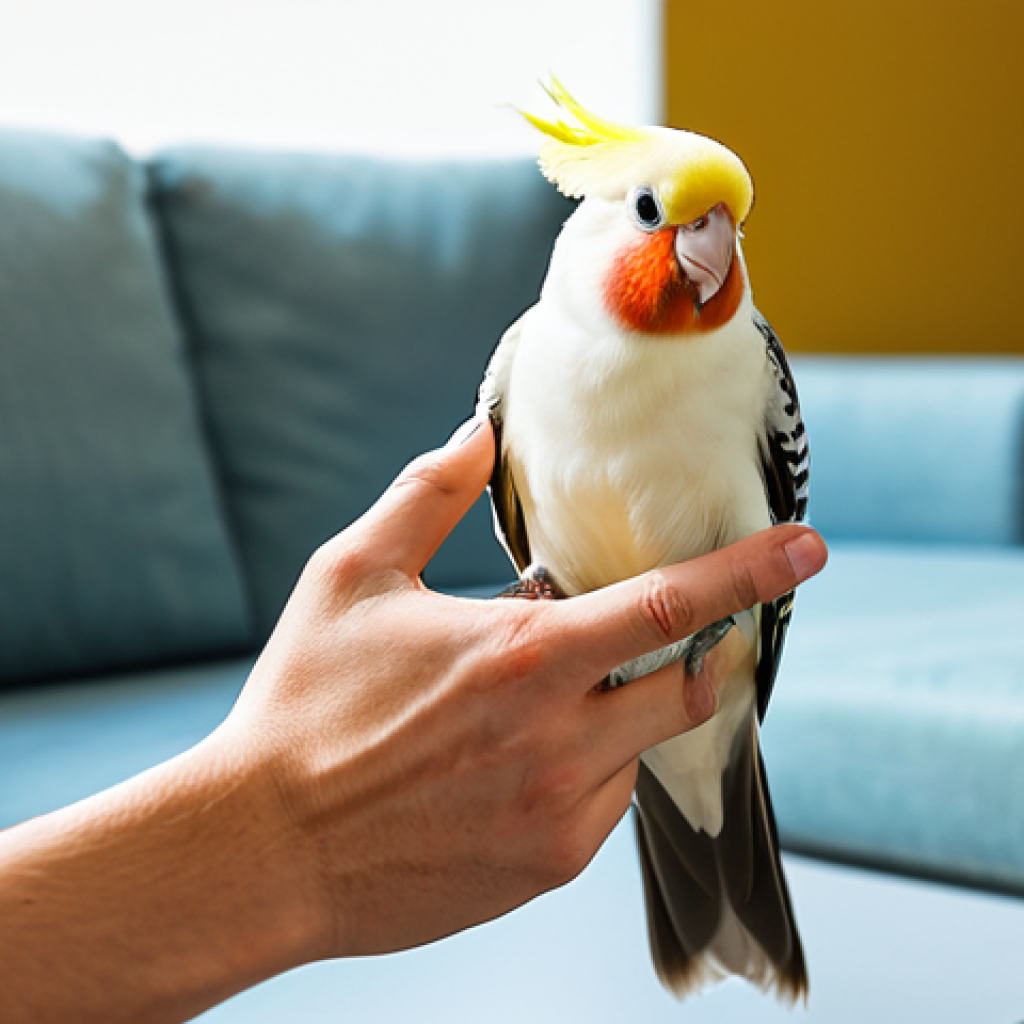You just brought home that adorable little cockatiel, full of chirps and curiosity, and now you’re probably wondering, “How do I even begin to train them?” Believe me, I’ve been there!
It’s not just about teaching a few basic commands; it’s about forging a deep, trusting bond that truly enriches both your lives. The old ways of forceful methods are thankfully long gone; today, it’s all about positive reinforcement, infinite patience, and genuinely understanding their unique, quirky personalities.
My own experience, with countless hours spent observing and interacting with my feathered companions, has shown me that every gentle interaction builds the foundation for a lifelong friendship.
The sheer joy of seeing them confidently step onto your finger or even mimic a whistle is truly unparalleled, a testament to what gentle guidance can achieve.
It’s a journey, not a sprint, and yes, sometimes a bit frustrating, but always incredibly rewarding. Let’s dive deeper below.
Decoding Your Cockatiel’s Quirky Communications

One of the most fascinating aspects of sharing your life with a cockatiel is learning to understand their unique language. It’s not just about chirps and whistles; it’s a complex tapestry of body language, vocalizations, and subtle cues that, once you learn to read them, reveal so much about their emotional state and intentions. When I first brought my cockatiel, Pip, home, I spent hours just observing her. I quickly realized that a cockatiel with slightly puffed-up feathers and relaxed posture was content, perhaps even sleepy, while a bird with tightly plastered feathers and wide, darting eyes was likely feeling anxious or threatened. This initial phase of observation, truly immersing myself in their world, was far more crucial than any command I could have tried to teach her immediately. It taught me patience and empathy, laying the groundwork for all future interactions. Understanding their distress calls, their happy chirps, or even their “I want attention” squawks helps you respond appropriately, building a rapport that transcends simple training exercises. It’s like learning a new dialect, and every successful interpretation feels like a small victory, deepening your connection with these intelligent little creatures.
1. Interpreting Vocalizations and Body Language
Just like humans, cockatiels use a wide range of sounds and movements to express themselves. Their specific vocalizations can tell you if they’re happy, annoyed, fearful, or even just calling out for you. I’ve learned that a soft, repetitive chirping often means contentment, especially when accompanied by grinding their beak – a clear sign of comfort. On the other hand, a sudden, piercing screech usually indicates alarm or a strong desire for something, whether it’s food or attention. Observing their crest position is also vital; a raised crest can signify excitement or alertness, while a flattened crest might suggest fear or aggression. Over time, you’ll start to recognize patterns unique to your own bird.
- Happy Chirps: Often soft, repetitive, and accompanied by beak grinding or light preening.
- Alarm Screeches: Loud, sharp, and usually accompanied by a stiff posture or sudden movement.
- Hissing: A sign of fear or aggression, often when feeling cornered or threatened.
- Contact Calls: Repetitive, slightly louder chirps or whistles, used to locate you or other birds.
2. Recognizing Signs of Stress or Discomfort
Knowing when your cockatiel is uncomfortable is just as important as knowing when they’re happy. Signs of stress can be subtle but crucial to recognize for effective, positive training. My bird, Nimbus, used to pluck a few feathers when she was feeling particularly stressed by a new environment. Other indicators include heavy breathing, continuous pacing, or a reluctance to engage. If you notice these signs, it’s a clear signal to pause the training session, allow them to decompress, and reassess your approach. Pushing them when they’re stressed will only erode trust and make future training much harder. Sometimes, simply giving them space and speaking to them softly in a calm voice is the best training you can do.
Cultivating an Unbreakable Bond: The Trust Foundation
Before you can even dream of teaching your cockatiel fancy tricks or complex commands, you absolutely must establish a bedrock of trust. This isn’t just a nice-to-have; it’s the very foundation upon which all successful training and a fulfilling relationship are built. I remember when I first got Luna, my most timid cockatiel. She was terrified of hands, flinching at my every move. It took weeks, sometimes even months, of simply being present, speaking softly, and offering treats without expectation, before she even considered approaching me. This period of quiet, consistent presence is where the magic truly happens. It’s about showing them, through your actions, that you are not a predator, but a safe, predictable, and benevolent presence in their world. This involves moving slowly, avoiding sudden movements, and always approaching them from a non-threatening angle. I’ve found that simply sitting near their cage, reading a book or gently humming, allows them to get used to your presence without feeling pressured. This passive interaction is incredibly powerful for building confidence in a fearful bird, slowly convincing them that your intentions are always good.
1. The Art of Gentle Acclimation and Positive Association
Acclimation isn’t a one-time event; it’s an ongoing process, especially in the early days. When I first introduced Pip to her new home, I made sure her cage was in a quiet, low-traffic area for the first few days, allowing her to adjust without feeling overwhelmed. Gradually, I moved the cage to a more central, yet still calm, part of the house. The key here is consistency and positive association. Every interaction should ideally end on a positive note. Offering a favorite treat, like a millet spray, through the bars of the cage while speaking in a calm, soothing voice, teaches them that your presence brings good things. Never force interaction. If they seem agitated or try to flee, just calmly withdraw your hand and try again later. This patience, though challenging at times, pays dividends in a confident and trusting bird.
2. Essential Tools for Bond Building
While patience and consistency are your primary tools, a few physical items can significantly aid in building trust and facilitating early interactions. I’ve personally found these items indispensable in my journey with several cockatiels. These are not just objects; they are extensions of your intention to connect with your bird in a safe and reassuring way. Having the right tools on hand can make a world of difference when you’re trying to bridge that initial gap of apprehension and foster a sense of security in your feathered friend. Always remember, the best tools are those that facilitate gentle, unforced interaction.
| Tool | Purpose & Benefits | How I Use It |
|---|---|---|
| Millet Spray | High-value, irresistible treat; perfect for initial positive reinforcement. Helps shy birds approach. | I hold a small piece through the cage bars, encouraging them to nibble without direct hand contact initially. |
| Target Stick | Used for target training, allows for hands-off guidance during early training steps. | I teach them to touch the stick with their beak for a treat, moving towards step-up without direct hand pressure. |
| Comfort Perch | A favorite, often textured, perch for them to feel secure on, especially outside the cage. | I place it near me during out-of-cage time, giving them a familiar, safe spot to land. |
| Clicker | Marks the exact moment of desired behavior, making training clear and efficient. | I pair the click with a treat immediately after they perform a desired action, like stepping up. |
Mastering the “Step Up”: Your First Major Breakthrough
The “step up” command is arguably the most fundamental and universally useful behavior you can teach your cockatiel. It’s not just a trick; it’s a critical safety measure, allowing you to easily move your bird, get them out of their cage, or safely return them. For me, teaching Pip to reliably step up was a monumental achievement, a true indicator that our bond had deepened. It wasn’t an overnight success; it required immense patience and a consistent, positive approach. The moment she confidently hopped onto my finger for the first time, without hesitation, was truly exhilarating – a testament to weeks of effort. This command empowers both you and your bird; it gives them agency in their movement while giving you the ability to ensure their safety. It’s the gateway to so much more interaction and freedom within your home, provided they feel secure doing it.
1. The Step-by-Step Approach to Success
Teaching the step-up begins with trust. Start by offering your finger or a perch just outside the cage, without pushing it into their space. When they seem comfortable with your hand nearby, gently press your finger against their lower chest, just above their legs, while saying “step up.” The key is gentle pressure; don’t push them off balance. The natural instinct of a bird is to step onto a higher perch when pressure is applied to their chest. As soon as they shift their weight, even slightly, praise them enthusiastically and offer a treat. I’ve found that even the smallest positive response needs to be rewarded instantly. Repeat this process in short, frequent sessions, always ending on a good note. If they seem reluctant, revert to simply offering treats from your hand until they are comfortable again.
2. Troubleshooting Common Step-Up Hurdles
It’s easy to get discouraged when your cockatiel isn’t instantly grasping the step-up, but believe me, resistance is a normal part of the learning process. One common issue I encountered with Nimbus was her tendency to bite when I tried to offer my finger. In these cases, I would use a small stick or a favorite perch initially instead of my finger. This allows them to learn the command without associating your hand with something intimidating. Another frequent challenge is a bird that simply refuses to budge. This often indicates a lack of trust or fear. Revisit the bonding exercises, offer more treats, and reduce the duration of your training sessions. Sometimes, just changing the environment to a calmer, quieter room can make a significant difference. Remember, consistency and a calm demeanor on your part are crucial for overcoming these hurdles.
Beyond Commands: Whistle Training and Mimicry Marvels
Once you’ve established basic trust and commands like “step up,” you can explore the incredibly rewarding world of whistle training and encouraging mimicry. Cockatiels are renowned for their ability to mimic sounds, from common household noises to complex melodies, and even human speech. This isn’t just a parlor trick; it’s a testament to their intelligence and a fantastic way to engage their minds. My cockatiel, Sparky, learned to whistle a segment of the ‘Addams Family’ theme song, and it never fails to bring a smile to my face. The sheer delight of hearing your bird perfectly reproduce a tune you’ve taught them, or even spontaneously mimic a sound from your environment, is truly one of the greatest joys of cockatiel ownership. It demonstrates a deep level of engagement and comfort within their environment, proving they feel secure enough to express their natural capabilities. This playful aspect of training truly enriches your relationship and provides endless entertainment.
1. The Art of Teaching Melodies and Sounds
Teaching your cockatiel to whistle a specific tune requires repetition, patience, and a bit of theatrical flair. Start with a short, simple, and distinct melody. Whistle it clearly and consistently whenever you are near your bird. I always found it helpful to associate the whistling with positive interactions, like offering a treat or gentle head scratches. Repetition is key; whistle the same tune multiple times a day, every day. You’ll often hear them trying to imitate you, sometimes sounding quite comical at first. Celebrate every small success, even if it’s just a rough approximation of the tune. Praise and a treat at that moment will reinforce the behavior. As they get better, you can gradually introduce longer phrases or more complex sounds. Some cockatiels will even pick up phrases or alarm sounds they hear regularly, so be mindful of what you expose them to!
2. Encouraging Mimicry and Speech Attempts
While cockatiels are more known for whistling than for extensive speech, some can learn to mimic words and phrases, especially males. The principle is similar to whistle training: consistent repetition and positive reinforcement. Choose a simple, short word or phrase, like “hello” or their name. Say it clearly and cheerfully every time you approach their cage or interact with them. Associate it with positive things, like feeding time or a favorite toy. I found that saying “Good morning, Pip!” every day as I uncovered her cage eventually led to her chirping something that sounded remarkably like “morning!” Repetition throughout the day, in a high-pitched, enthusiastic voice, significantly increases the chances of them picking it up. Be realistic with expectations; not every cockatiel will become a great talker, but most will enjoy the challenge and interaction of learning new sounds.
Navigating Training Hurdles: Patience and Problem-Solving
No training journey is without its bumps and detours. You’ll encounter days where your cockatiel seems completely uninterested, or perhaps even regresses on a command they once knew perfectly. Believe me, I’ve had my fair share of frustrating moments, wondering if I was doing something wrong or if my bird just wasn’t “getting it.” But these hurdles are not failures; they are opportunities for growth and deeper understanding of your bird’s individual personality. The key is to approach these challenges with immense patience, a willingness to adapt your methods, and a strong problem-solving mindset. What works for one bird might not work for another, and what works today might not work tomorrow. It’s about being a detective, observing their reactions, and trying different approaches until you find what resonates with your specific feathered friend in that specific moment. This adaptability is perhaps the most important skill a bird owner can possess.
1. Addressing Biting and Nipping Behaviors
Biting can be one of the most disheartening behaviors to encounter during training, and it’s a common issue, especially with younger birds or those feeling insecure. It’s crucial to understand that a bite is almost always a form of communication, not an act of malice. My first cockatiel, Echo, was quite nippy, and I quickly learned that her bites were usually a sign that she felt overwhelmed, scared, or simply didn’t want to do what I was asking. The best way to address biting is to prevent it. Observe your bird’s body language; a flattened crest, dilated pupils, or a hiss are all warnings. If you see these, stop what you’re doing and give them space. If they do nip, avoid yelling or jerking your hand away violently, as this can scare them further or reinforce the idea that biting gets a reaction. Instead, calmly but firmly say “no,” and withdraw your hand for a moment. Offer a toy or a different interaction that they can direct their energy towards, redirecting the behavior. Always reward non-biting interactions, no matter how small.
2. Overcoming Fear and Shyness
Some cockatiels are naturally more timid than others, and it takes an extra dose of patience and understanding to help them overcome their fears. I’ve worked with rescue birds that were terrified of hands, and it felt like every step forward was met with two steps back. The most important thing is never to force interaction. If your bird is visibly trembling, puffing up, or trying to hide, stop immediately. Instead, focus on building positive associations without direct contact. Simply sitting near their cage and reading aloud, or gently talking to them, allows them to get used to your presence. Offering treats through the cage bars, or placing them in a dish near where you are sitting, encourages them to associate you with positive experiences. Gradually, very gradually, introduce your hand into their space, always letting them approach you on their terms. This slow, trust-building process can take weeks or even months, but the transformation from a fearful bird to a confident, affectionate companion is incredibly rewarding.
Enrichment, Play, and the Holistic Approach to Well-being
Training a cockatiel isn’t solely about teaching commands; it’s about providing a rich, stimulating environment that caters to their natural behaviors and intelligence. A bored bird is often a problematic bird. I’ve always made it a point to ensure my cockatiels have a diverse range of toys, opportunities for exploration, and plenty of time out of their cage. This holistic approach to their well-being directly impacts their trainability and overall happiness. When a bird is mentally and physically stimulated, they are far more receptive to learning and less likely to develop undesirable behaviors stemming from boredom or frustration. It’s a joy to watch them explore a new toy, shred a piece of cardboard, or forage for treats hidden around their play stand. These activities mimic what they would do in the wild, engaging their innate instincts and keeping their minds sharp. Neglecting enrichment is like asking a human to sit in an empty room all day – it’s detrimental to their mental health and ultimately to your bond.
1. The Importance of Varied Toys and Foraging Opportunities
Toys are not just for fun; they are crucial for mental stimulation and preventing boredom. I make sure to rotate my cockatiels’ toys regularly, introducing new textures, shapes, and challenges to keep things interesting. Think shreddable toys made of paper or cardboard, chew toys made of safe wood, and puzzle toys that require them to figure out how to get a treat. Foraging toys, where they have to work to find their food, are particularly effective. I often hide small seeds or pieces of their favorite vegetable in paper cups or within a toy, encouraging them to use their natural foraging instincts. This not only keeps them busy but also provides a healthy outlet for their energy and intelligence, making them more content and less prone to destructive behaviors like feather plucking.
2. Safe Out-of-Cage Time and Social Interaction
While a secure cage is essential, cockatiels thrive on out-of-cage time, provided it’s supervised and safe. This allows them to stretch their wings, explore, and most importantly, interact with you on your terms. I typically set up a designated “play area” with a bird-safe play stand, some toys, and perches where they can hang out while I’m in the room. This direct interaction, whether it’s gentle petting, talking to them, or engaging in a game of chase the toy, significantly strengthens your bond. It’s during these moments that their personalities truly shine, and they feel like a true part of the family. Never leave them unsupervised outside their cage, as even seemingly safe environments can hide hazards. Consistent, positive social interaction during their out-of-cage time reinforces their trust and makes them more eager to engage in training sessions.
Sustaining the Journey: Continuous Learning and Love
Bringing a cockatiel into your life and embarking on the training journey is not a one-time event; it’s a continuous, evolving process of learning, adaptation, and deepening love. Just like any relationship, the one you build with your cockatiel requires ongoing effort and attention. My most profound realization over the years has been that every day offers a new opportunity to learn something about them, to reinforce a positive behavior, or simply to enjoy their companionship. It’s about celebrating the small victories, patiently navigating the occasional setbacks, and always maintaining a positive and understanding attitude. The bond you forge is incredibly special, and it’s sustained not by perfection, but by consistent, gentle interaction and an unending supply of affection. There will be days when they amaze you with their intelligence and affection, and days when they test your patience, but through it all, the unconditional love they offer makes every moment worthwhile. This journey, filled with chirps, whistles, and the soft ruffle of feathers, is truly a gift.
1. Reinforcing Behaviors and Preventing Regression
Just like with humans, learned behaviors in cockatiels can fade if not consistently reinforced. Once your cockatiel has mastered a command, don’t stop practicing it. Integrate it into your daily routine. For example, always ask for a “step up” when taking them out of their cage. Continue to offer praise and occasional treats for good behavior, even if it’s something they’ve known for ages. I’ve found that short, spontaneous “refresher” sessions, even for just a few minutes, keep their skills sharp and prevent them from forgetting commands. If you notice any regression, don’t get frustrated. Revert to earlier, simpler steps of the training, and build up again slowly. Sometimes, a change in environment or a period of stress can cause a temporary setback, and patience is your best friend in these moments.
2. Celebrating Milestones and Cherishing the Bond
It’s incredibly important to celebrate every milestone, no matter how small. The first time they step up confidently, the first whistle they mimic, the first time they voluntarily fly to you – these are all huge achievements for your bird and for your relationship. Acknowledge these moments with enthusiastic praise, their favorite treat, or extra snuggles. These celebrations not only reinforce the behavior but also make the training journey more enjoyable for both of you. Beyond training, simply cherishing the unique personality of your cockatiel is paramount. Take time to simply observe them, talk to them, or let them perch on your shoulder while you go about your day. The true reward of this journey isn’t just a well-trained bird, but a deeply connected, loving companion who brings immense joy into your life. It’s a friendship built on trust, respect, and mutual understanding, and that’s a bond truly worth nurturing.
Concluding Remarks
As we wrap up this comprehensive guide, remember that true success in training your cockatiel isn’t just about perfected commands; it’s about the incredible bond you build. Every gentle interaction, every moment of shared understanding, and every patient step forward deepens a relationship unlike any other. Keep learning, keep loving, and cherish the unique personality that makes your feathered companion so special. The journey with a cockatiel is a continuous dance of discovery and affection, a truly rewarding experience for both of you.
Useful Information
1. Nutrition is Key: A balanced diet of high-quality pellets, fresh vegetables, and some fruit is crucial for your cockatiel’s health and energy levels, directly impacting their receptiveness to training. Avoid seed-only diets.
2. Regular Vet Check-ups: Annual avian vet visits are essential. Birds are masters at hiding illness, so regular check-ups can catch issues early, ensuring your bird remains healthy and happy enough to engage in training.
3. Safe Cage Environment: Provide a spacious cage with varied perches (different textures and diameters), food/water dishes, and a variety of toys. A secure and stimulating home base reduces stress and promotes overall well-being.
4. Household Safety First: Always supervise your cockatiel during out-of-cage time. Be aware of common household dangers like open windows, toxic plants, cleaning products, hot stoves, and other pets. Safety is paramount.
5. Respect Their Individuality: Just like humans, every cockatiel has a unique personality, learning pace, and preferences. What works for one bird might not work for another; adapt your approach to suit your specific feathered friend.
Key Takeaways
Building a strong, trusting relationship is the absolute foundation for all successful cockatiel training. Patience, consistency, and positive reinforcement are your most powerful tools. Always observe your bird’s body language and respect their emotional state, adapting your approach when they show signs of stress or fear. Remember that training extends beyond commands to include enrichment, play, and a holistic approach to their well-being, fostering a deep, joyful, and lifelong bond.
Frequently Asked Questions (FAQ) 📖
Q: So, I just brought my little chirper home. What’s the absolute first step I should take to start building this bond you’re talking about, before even thinking about tricks?
A: Oh, I totally get that feeling – a mix of excitement and “what now?!” When I first brought home my feathery friend, a little grey cockatiel I named Nimbus, my instinct was to jump right into interacting.
But honestly, the very best first step is to do… almost nothing. Seriously! Give them space.
Place their cage in a room where they can observe daily life, but aren’t constantly bombarded. For the first few days, maybe even a week, just let them settle in.
Talk to them in a soft, gentle voice as you walk by, offer treats through the bars if they seem curious, but don’t try to force interaction. I used to just sit quietly near Nimbus’s cage, reading a book or listening to music, just letting her get used to my presence.
It’s about building a sense of security and trust, showing them “this human isn’t a threat,” before you even think about finger training or whistles. That quiet, patient beginning sets the foundation for everything that follows.
You’ll know when they’re ready – they’ll start perking up, maybe even chirping back when you talk.
Q: Okay, but let’s be real – sometimes it feels like they’re just not “getting it” or they’re completely ignoring me. How do you handle those moments when the frustration starts creeping in, and you feel like you’re getting nowhere?
A: Oh, believe me, I’ve had more than my fair share of those days! It’s like, you’re trying to teach them to step up, and they’re just staring at you, blinking slowly, like you’re speaking a foreign language.
My little Pippin, bless her heart, went through a phase where she just flat-out refused to even acknowledge my hand. In those moments, the absolute worst thing you can do is get angry or pushy.
What I learned, through many failed attempts and a few deep breaths, is that it’s often us who needs a break, not them. If I feel that familiar tug of frustration, I immediately stop the session.
No scolding, no “bad bird,” just a quiet retreat. Maybe they’re tired, or overstimulated, or just not in the mood. Just like us, they have off days!
Instead, try again later, or even the next day. Sometimes, I’d switch to something super easy, like offering a favorite treat just for being near me, to end on a positive note.
Remember, every positive interaction, no matter how small, is a step forward. Don’t be afraid to try a different approach, or just give them a bit of quiet time.
Patience isn’t just a virtue; it’s the secret sauce for successful bird training!
Q: You talked about understanding their “unique, quirky personalities.” How do I actually go about figuring out what makes my individual cockatiel tick, and why is that so important for successful training?
A: This is probably the most fascinating part of the journey, honestly! Every single cockatiel is a tiny individual, a little feathered character with their own quirks, fears, and joys.
My first cockatiel, Jasper, was incredibly curious and loved anything new; training him was about introducing novel toys and sounds. My second, a little female named Sunny, was much shyer and highly food-motivated; she learned best with tiny, high-value treats and a very gentle, predictable routine.
You figure this out through sheer observation, pure and simple. Spend time just watching them. When do they seem most active?
What sounds do they react to? Do they prefer certain toys? Are they easily startled, or are they bold and exploratory?
Do they sing a lot, or are they more vocal in other ways? Maybe they love head scratches, or perhaps they’re not into touch at all yet. Once you start noticing these little things, you can tailor your training.
If your bird is food-motivated, tiny millet sprays are your best friend. If they love praise, verbal encouragement will go a long way. If they’re a bit anxious, keep sessions super short and predictable.
It’s like learning their unique language, and once you start speaking it, the whole training process becomes less about forcing and more about a joyful, shared discovery.
It’s truly amazing to witness their personalities unfold!
📚 References
Wikipedia Encyclopedia
구글 검색 결과
구글 검색 결과
구글 검색 결과
구글 검색 결과
구글 검색 결과






